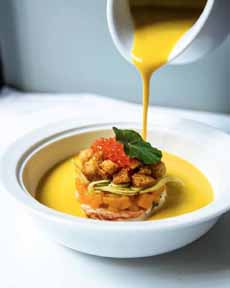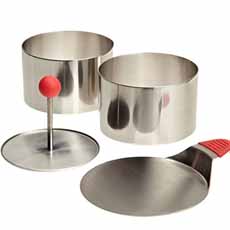TIP OF THE DAY: Soup Napoleon & Uses For Ring Molds
|
What’s a soup napoleon? It’s a name we gave to this recipe concept from Vaucluse restaurant in New York City. It sounds more appealing than “stack” or “cylinder” and more accurate than “tower.” A pastry napoleon is a stack of layered pastry, custard, and optionally, fruit. The mechanics are simple: A stack of four or five layers of contrasting ingredients are set in a ring mold in the dish. The ring mold is removed, and the soup is poured (ideally from a pitcher) around the cylinder/stack/tower. It’s a dramatic presentation when done at the table (photo #1). From the kitchen, bring the dishes of cylinders and place them in front of the diners; then pour the soup around the cylinder. It’s a substantial first course; and can be made in a larger portion as a vegetarian main course. While it may look complicated, it doesn’t take any great skill. Beyond preparing (or buying) the soup, the only time-consuming part is chopping, slicing, and forming the stacks. You can also serve the napoleon without the soup (photo #2): on a plate with a drizzle or dots of sauce or balsamic glaze around it, or on a bed of greens. The stack can include whatever you like. But first, pick a direction: After the napoleon is built, squash soup is added, almost to the top of the lobster layer, or whatever your first layer is. You don’t need to serve a lot of soup: an inch of it is fine. Just make your bottom layer at least an inch deep. The other layers can be as deep or narrow as you like. To choose your ingredients, use layers of different colors and textures. Examples: The only special item you need is a ring mold (photo #3). |
 [1] Squash soup with lobster napoleon, at Vaucluse in New York City. It’s topped with salmon caviar and nasturtium leaves.
|
|
|
Note that size is important. If you have a large ring mold, the stack will take up much of the bowl. The larger the stack, the less soup. There’s no right or wrong: It’s how you want to present the dish. Ring molds are inexpensive, but if you want to experiment without buying one, just remove the top and bottom from shorter cans of food. Ring molds are cylinders with open ends that are used for food styling and presentations (photo #3). They are made in a variety of diameters and heights. They are primarily used to form food(s) into towers/cylinders/stacks: forming appetizers and crab cakes, molding salads and steak tartare, vegetable timbales, and desserts. You can also use them to cook food in a perfectly round shape: eggs and pancakes, for example. You can also use them to cut perfectly round burgers or sliders; biscuits, gelatin, pastry and polenta. The rings are made from stainless steel. We prefer those that come with a tamping device, which helps to pack the food in tightly. The napoleon, known best as a layered custard pastry, was not named after Emperor Napoleon. It isn’t even French. It was created in Naples, Italy, where it was known as a napolitano. The name translated to napoleon in French and English.
|
||




